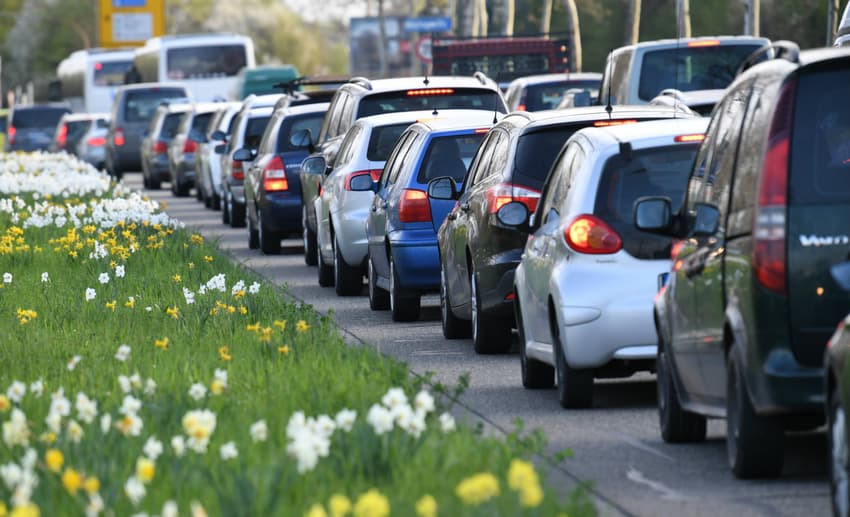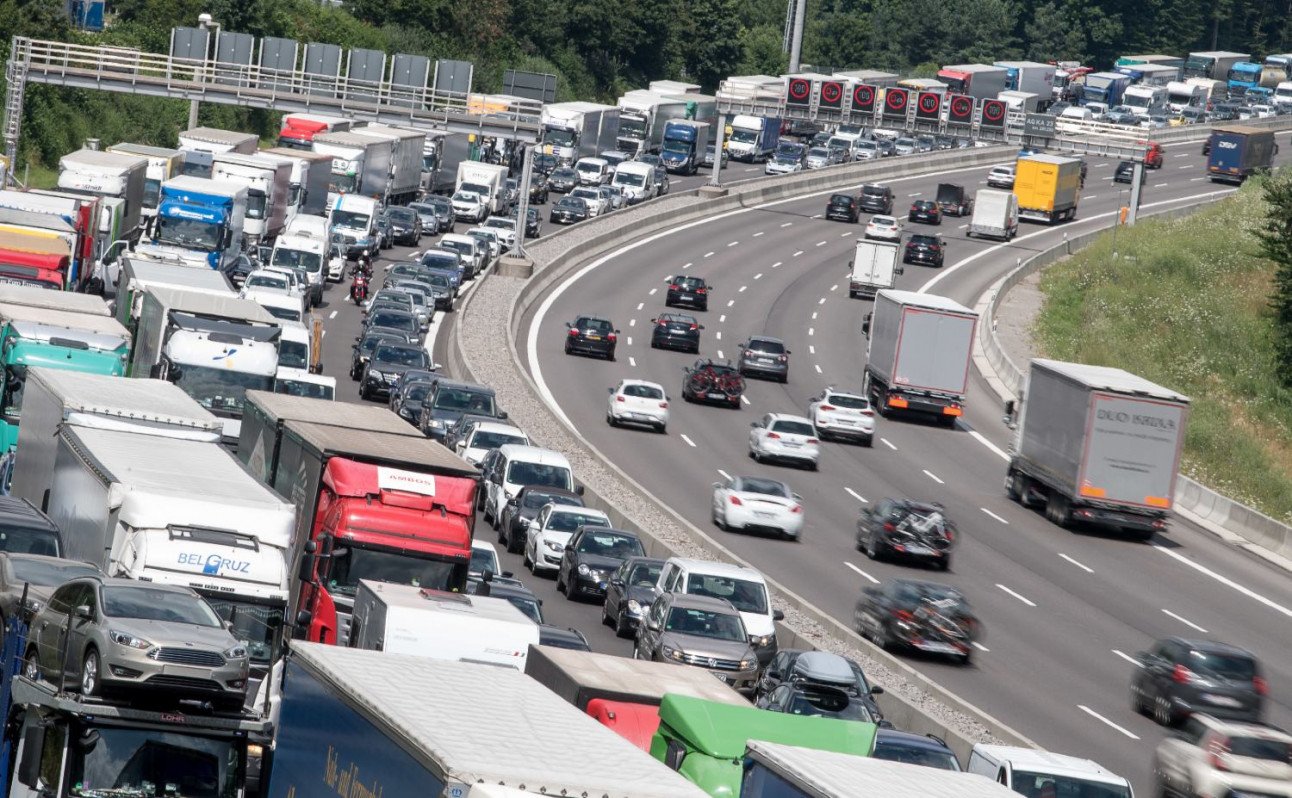How the commute to work in Germany is changing

Added stress and high costs: commuting is an unfortunate part of everyday life for an ever-growing amount of people in Germany.
As well as the increasing number of workers shuttling between the Bundesländer (federal states), districts and other municipal boundaries, the average length of the trip has also risen.
Social security contributions revealed that last year there were 3.40 million employees who worked outside of the state they live. The year before, there were 50,000 fewer – and there were only 2.14 million in 1999.
These statistics were pulled from data on commuters by the Federal Employment Agency (BA), which the Left (Die Linke) politician Sabine Zimmermann analyzed.
SEE ALSO: Record 745,000 traffic jams on Germany's Autobahn
More than 19 million workers in Germany commute
In 2018, almost 60 percent of all employees left their communities to get to work, while in 2000 it was only 54 percent, according to a separate evaluation by the Federal Institute for Building, Urban and Spatial Research (Bundesinstitut für Bau-, Stadt- und Raumforschung).
That data shows that 19.3 million employees commute regularly now. In 2000 the number was 14.94 million. The strong increase is mainly due to the increase in employment in recent years.
But it could also partly be down to pressure on workers to stay in employment in the precarious job market.
More employees also leave their city or district on the way to work; 12.6 million in 2018, while in 2000 it was only 9.3 million.
The Federal Institute has also found that the average length of commuting increased from 14.8 kilometres in 2000 to 16.9 kilometres in 2018.
"The pressure to be mobile at work and to travel long distances for work has continued unabated in recent years," Left politician Zimmermann told DPA.
 Drivers near Stuttgart. Photo: DPA
Drivers near Stuttgart. Photo: DPA
The price is an increasing amount of stress, especially for long-distance commuters, impacting all aspects of life, including health and safety, she added.
East to west
Routes to the labour market centres are particularly long in the sparsely populated areas away from the metropolitan areas, researchers explain.
In large parts of Mecklenburg-Western Pomerania, Brandenburg and Saxony-Anhalt, employees travel an average of more than 30 kilometres on their way to work.
There are still significantly more employees from eastern Germany who go to work in the western federal states than in the opposite direction.
According to BA figures, around 415,000 eastern German employees commuted to the west in 2019. Conversely, 178,000 people came to work in the east from western Germany.
Hundreds of thousands of people commute to the major cities. According to the Federal Institute, Munich is the top destination: here around 390,000 employees from another district came to work in the city.
Munich is followed by Frankfurt am Main (374,000), Hamburg (350,000) and Berlin (315,000).
Conversely, employees are increasingly commuting from large cities to jobs in the surrounding area or to other large cities, the Federal Institute also found.
READ ALSO: What you need to know about getting a German driving license
More frequent, but shorter traffic jams
Traffic jams are a major problem for commuters. According to the ADAC automobile club, the total duration of traffic jams reported on German motorways increased significantly last year.
At the same time, however, the number and the distance covered by reported traffic jams decreased.
In total, traffic stalled nationwide for 521,000 hours in 2019, an increase of just under 14 percent.
With around 708,500 reported traffic jams, there were 5 percent less than in the previous year, and their overall length also decreased by around 1.42 million kilometers, or seven percent.
Employers should consider work schedules that give employees the proper flexibility to counteract commuting stress, Zimmermann said.
The fact that more people commute from east to west is also an expression of the low wages in the eastern federal states, she said. Working on fixing the imbalance would relieve the burden on the eastern German labour market considerably.
Comments
See Also
As well as the increasing number of workers shuttling between the Bundesländer (federal states), districts and other municipal boundaries, the average length of the trip has also risen.
Social security contributions revealed that last year there were 3.40 million employees who worked outside of the state they live. The year before, there were 50,000 fewer – and there were only 2.14 million in 1999.
These statistics were pulled from data on commuters by the Federal Employment Agency (BA), which the Left (Die Linke) politician Sabine Zimmermann analyzed.
SEE ALSO: Record 745,000 traffic jams on Germany's Autobahn
More than 19 million workers in Germany commute
In 2018, almost 60 percent of all employees left their communities to get to work, while in 2000 it was only 54 percent, according to a separate evaluation by the Federal Institute for Building, Urban and Spatial Research (Bundesinstitut für Bau-, Stadt- und Raumforschung).
That data shows that 19.3 million employees commute regularly now. In 2000 the number was 14.94 million. The strong increase is mainly due to the increase in employment in recent years.
But it could also partly be down to pressure on workers to stay in employment in the precarious job market.
More employees also leave their city or district on the way to work; 12.6 million in 2018, while in 2000 it was only 9.3 million.
The Federal Institute has also found that the average length of commuting increased from 14.8 kilometres in 2000 to 16.9 kilometres in 2018.
"The pressure to be mobile at work and to travel long distances for work has continued unabated in recent years," Left politician Zimmermann told DPA.
 Drivers near Stuttgart. Photo: DPA
Drivers near Stuttgart. Photo: DPA
The price is an increasing amount of stress, especially for long-distance commuters, impacting all aspects of life, including health and safety, she added.
East to west
Routes to the labour market centres are particularly long in the sparsely populated areas away from the metropolitan areas, researchers explain.
In large parts of Mecklenburg-Western Pomerania, Brandenburg and Saxony-Anhalt, employees travel an average of more than 30 kilometres on their way to work.
There are still significantly more employees from eastern Germany who go to work in the western federal states than in the opposite direction.
According to BA figures, around 415,000 eastern German employees commuted to the west in 2019. Conversely, 178,000 people came to work in the east from western Germany.
Hundreds of thousands of people commute to the major cities. According to the Federal Institute, Munich is the top destination: here around 390,000 employees from another district came to work in the city.
Munich is followed by Frankfurt am Main (374,000), Hamburg (350,000) and Berlin (315,000).
Conversely, employees are increasingly commuting from large cities to jobs in the surrounding area or to other large cities, the Federal Institute also found.
READ ALSO: What you need to know about getting a German driving license
More frequent, but shorter traffic jams
Traffic jams are a major problem for commuters. According to the ADAC automobile club, the total duration of traffic jams reported on German motorways increased significantly last year.
At the same time, however, the number and the distance covered by reported traffic jams decreased.
In total, traffic stalled nationwide for 521,000 hours in 2019, an increase of just under 14 percent.
With around 708,500 reported traffic jams, there were 5 percent less than in the previous year, and their overall length also decreased by around 1.42 million kilometers, or seven percent.
Employers should consider work schedules that give employees the proper flexibility to counteract commuting stress, Zimmermann said.
The fact that more people commute from east to west is also an expression of the low wages in the eastern federal states, she said. Working on fixing the imbalance would relieve the burden on the eastern German labour market considerably.
Join the conversation in our comments section below. Share your own views and experience and if you have a question or suggestion for our journalists then email us at [email protected].
Please keep comments civil, constructive and on topic – and make sure to read our terms of use before getting involved.
Please log in here to leave a comment.